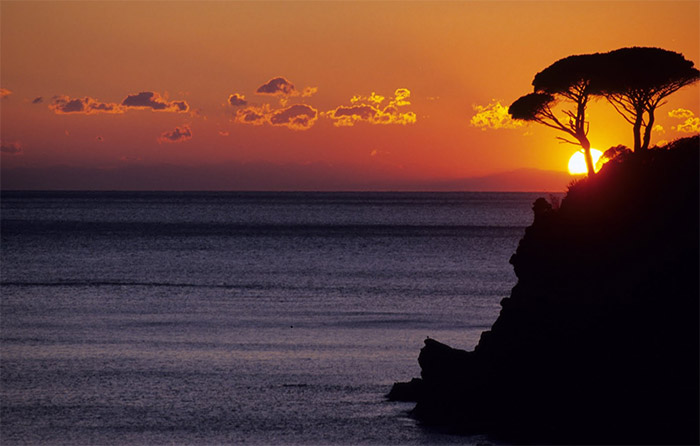
Tramonto (Rosso di sera) - Foto di:
Daniele Parodi
CIELO ROSSO
RED SKY
[ITALIANO] Rosso di
sera bel tempo si spera,
rosso di mattina mal tempo si avvicina
[ITALIANO] Alba rossa, o vento o goccia
[CORSO] Aria rossa
di matina, minaccia ruvina;
aria rossa di sera, bon tempu spera
[INGLESE] Red sky
at night, sailor’s delight;
red sky in the morning, sailor takes warning
[INGLESE] Red sky at night, shepherds delight;
red sky in morning, shepherds’ warning
[INGLESE] If red the sun begin his race,
be sure the rain will fall apace
[INGLESE] If the morning sky is red,
the ewe and her lamb will go wet to bed
[FRANCESE] Ciel
rouge le soir, laisse bon espoir;
ciel rouge le matin, pluie en chemin
[FRANCESE] Ciel rouge au matin est un pluvieux voisin
[SPAGNOLO] Cielo
rojo al anochecer, le gusta al pastor;
cielo rojo al amanecer, le avisa al pastor
[CATALANO] Sol
rogenc al vespre, demà al matí a la finestra
[OLANDESE]
Avondrood, morgen mooi weer aan bood,
ochtendrood, vanavond water in de sloot
Rosso di sera, promessa di un buon giorno successivo, rosso di
mattina, acqua nel fosso
Red sky at night, a promise of good next day, red sky in the morning,
water in the ditch
[DANESE] Morgenrøde
gir dage bløde.
Kveldsrøde gir dage søde.
Una mattina rossa annuncia giorni bagnati. Una sera rossa annuncia
giorni dolci
A red morning heralds wet days. A red evening heralds sweet days
[NORVEGESE]
Aftenrøde gjør en god natt.
Men morgenrøde drypper i hatt
Il rosso di sera da una buona notte. La mattina rossa bagna il
cappello
Red sky at night says goodnight. Red sky in the morning makes your
hat wet
[SVEDESE]
Aftonrodnad har inget att sätta,
men morgonrodnad ger en våt hätta
Il rosso di sera non arreca nulla, ma il rosso di mattina bagnerà il
cappello
Red sky at night doesn’t carry anything , but red sky in the morning
will make your hat wet
[POLACCO] Gdy
czerwone słońce wschodzi w marynarzu bojaźń się rodzi
Lecz gdy czerwień o zachodzie, wie marynarz o pogodzie.
Quando il sole sorge rosso, il timore nasce nel marinaio. Quando
invece il rosso è al tramonto, gioia nel marinaio
When the sun rises red, the sailor is worried, When the sun is red
at dusk, the sailor is happy
[TEDESCO] Abendrot
- Gutwetterbot', Morgenrot mit Regen droht
Rosso di sera porta bel tempo, rosso al mattino minaccia con pioggia
Red sky at night carries fair weather, red sky in the morning
threatens with rain
[OCCITANO] Roginèla
del vèspre, regaudís lo mèstre; roginèla del matin, de pueja sus lo
camin
[MALTESE] Il-hmura
ta+ fil-ghaxija,
lestu d-debba ghat-tigrija;
il-hmura
ta’ fil-ghody,
halli
l-bhejjem joqoghdu
Rosso di sera, prepara la giumenta per la corsa; rosso di mattina,
lascia gli animali stare dove sono (perché farà cattivo tempo)
Red sky at night, you make the mare ready for the race. Red sky in
the morning, you let the animals stand where they are (because the
weather will be bad)
Vero o Falso?
Questo adagio si riferisce al moto da
ovest verso est dei sistemi atmosferici.
Al tramonto e all’alba, il sole si trova basso
all’orizzonte. La luce solare deve quindi attraversare più
atmosfera per raggiungere la superficie terrestre. La luce
solare nel suo tragitto investe particelle in grado di
deviarla e diffonderla. Più è corta la lunghezza d’onda
della luce (come per violetto e blu), più è probabile che
venga diffusa. La luce con lunghezza d’onda maggiori, come
arancione e rosso, tende a viaggiare più dritta. Inoltre al
tramonto e all’alba la luce solare deve attraversare i bassi
strati dell’atmosfera, che contengono particelle di sabbia,
sale, fumo e inquinanti. Se è presente una regione di alta
pressione, tali particelle sono forzate a rimanere più
vicino al suolo, deviando di più la luce azzurra e
rendendola quindi più rossa.
Se ad ovest è presente una regione di alta pressione, ne
segue un tramonto particolarmente rosso (“rosso di sera”).
Alle medie latitudini dell’emisfero nord i sistemi
atmosferici si spostano da ovest verso est. Siccome un
sistema di alta pressione porta in genere bel tempo, il
cielo rosso al tramonto è un indicatore di bel tempo nel
futuro prossimo (“bel tempo si spera”).
Al contrario, se il cielo è rosso al mattino, l’alta
pressione è ad est e una regione di bassa pressione potrebbe
essere in arrivo da ovest. La bassa pressione in genere è
connessa alla presenza di nuvole e pioggia (“mal tempo si
avvicina”).
True or False?
This proverb refers to typical motion
of the weather systems from west to east.
At dawn and sunset, the sun lies low in the sky. Sun light
has to travel through more atmosphere in order to reach
Earth surface, hitting particles and being scattered by them.
The shorter the wave length is (like violet and blue), the
more probably light is scattered. Light with longer wave
length (like orange and red) tends to travel straight ahead.
At dawn and sunset, sun light shines through much more of
the lower atmosphere, which contains dust, salt, smoke and
pollution. If an area of high air pressure is present, the
air sinks. This sinking air holds air contaminants near the
earth, making the sunset even redder than usual. This would
be the “red sky at night”.
In the middle latitudes of the northern hemisphere, weather
systems most often approach from the west. Since high
pressure generally brings fair weather, this type of red sky
at sunset would indicate that clear weather is approaching,
which would “delight” a sailor. If the sky is red in the
eastern morning sky for the same reasons as above, then the
high pressure region has most likely already passed from
west to the east, and an area of low pressure may follow.
Low pressure usually brings clouds, rain or storms, a
warning for sailors.
|